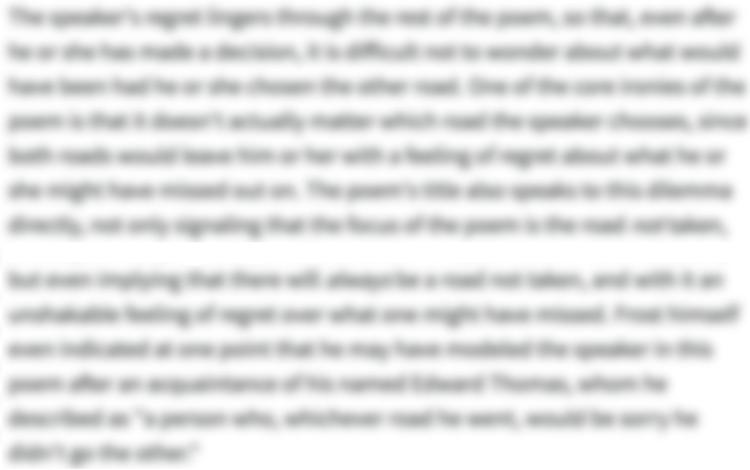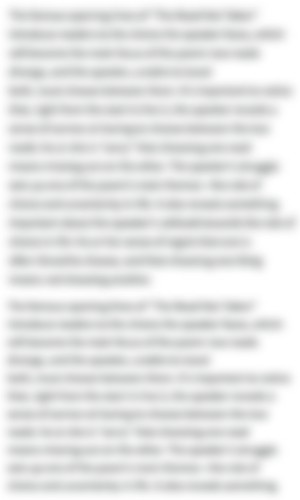The Full Text of “A Valediction: Forbidding Mourning”
1As virtuous men pass mildly away,
2 And whisper to their souls to go,
3Whilst some of their sad friends do say
4 The breath goes now, and some say, No:
5So let us melt, and make no noise,
6 No tear-floods, nor sigh-tempests move;
7'Twere profanation of our joys
8 To tell the laity our love.
9Moving of th' earth brings harms and fears,
10 Men reckon what it did, and meant;
11But trepidation of the spheres,
12 Though greater far, is innocent.
13Dull sublunary lovers' love
14 (Whose soul is sense) cannot admit
15Absence, because it doth remove
16 Those things which elemented it.
17But we by a love so much refined,
18 That our selves know not what it is,
19Inter-assured of the mind,
20 Care less, eyes, lips, and hands to miss.
21Our two souls therefore, which are one,
22 Though I must go, endure not yet
23A breach, but an expansion,
24 Like gold to airy thinness beat.
25If they be two, they are two so
26 As stiff twin compasses are two;
27Thy soul, the fixed foot, makes no show
28 To move, but doth, if the other do.
29And though it in the center sit,
30 Yet when the other far doth roam,
31It leans and hearkens after it,
32 And grows erect, as that comes home.
33Such wilt thou be to me, who must,
34 Like th' other foot, obliquely run;
35Thy firmness makes my circle just,
36 And makes me end where I begun.
-
“A Valediction: Forbidding Mourning” Introduction
-
John Donne, a 17th-century writer, politician, lawyer, and priest, wrote "A Valediction: Forbidding Mourning" on the occasion of parting from his wife, Anne More Donne, in 1611. Donne was going on a diplomatic mission to France, leaving his wife behind in England. A "valediction" is a farewell speech. This poem cautions against grief about separation, and affirms the special, particular love the speaker and his lover share. Like most of Donne's poems, it was not published until after his death.
-
-
“A Valediction: Forbidding Mourning” Summary
-
The speaker opens with an image of good men dying quietly, softly urging their souls to leave their bodies. These virtuous deaths are so imperceptible that the dying men's friends disagree about whether or not the men have stopped breathing yet.
The speaker argues that he and the lover he's bidding farewell to should take these deaths as a model, and part ways silently. They should not give in to the temptation to weep and sigh excessively. In fact, grieving so openly would degrade their private love by broadcasting it to ordinary people.
Natural earthly disturbances, such as earthquakes, hurt and scare human beings. Ordinary people notice these events happening and wonder what they mean. However, the movements of the heavens, while being larger and more significant, go unnoticed by most people.
Boring, commonplace people feel a kind of love that, because it depends on sensual connection, can't handle separation. Being physically apart takes away the physical bond that their love depends on.
The speaker and his lover, on the other hand, experience a more rare and special kind of bond. They can't even understand it themselves, but they are linked mentally, certain of one another on a non-physical plane. Because of this, it matters less to them when their bodies are apart.
The souls of the lovers are unified by love. Although the speaker must leave, their souls will not be broken apart. Instead, they will expand to cover the distance between them, as fine metal expands when it is hammered.
If their souls are in fact individual, they are nevertheless linked in the way the legs of a drawing compass are linked. The soul of the lover is like the stationary foot of the compass, which does not appear to move itself but actually does respond to the other foot's movement.
This stationary compass foot sits in the center of a paper. When the other compass foot moves further away, the stationary foot changes its angle to lean in that direction, as if longing to be nearer to its partner. As the moving foot returns, closing the compass, the stationary foot stands straight again, seeming alert and excited.
The speaker's lover, he argues, will be like his stationary foot, while he himself must travel a circuitous, indirect route. Her fixed position provides him with the stability to create a perfect circle, which ends exactly where it began—bringing the speaker back to his lover once again.
-
-
“A Valediction: Forbidding Mourning” Themes
-
Love and Distance
John Donne wrote “A Valediction: Forbidding Mourning” on the occasion of his separation from his wife, Anne, on diplomatic business. The poem concerns what happens when two lovers have to part, and explains the spiritual unification that makes this particular parting essentially unimportant. The speaker argues that separation should not matter to him and his lover because genuine love transcends physical distance.
A valediction is a farewell. Donne’s title, however, explicitly prohibits grief about saying goodbye (hence the subtitle of “Forbidden Mourning”) because the speaker and his lover are linked so strongly by spiritual bonds that their separation has little meaning. Indeed, the speaker characterizes himself and his lover as “Inter-assured of the mind.” Donne created this compound word—which combines the prefix “inter,” meaning mutually and reciprocally, with “assured,” meaning confident, secure, or dependable—to emphasize that the two lovers are linked by a mutual mental certainty about their love. They are so close in this way that the separation of their bodies doesn’t mean much.
The speaker further assures his lover that their souls, as well as their minds, are unified. Physical separation doesn’t “breach” or break this bond. Instead, their souls expand outward to cover the distance between them, as a soft metal is beaten to spread thinly over a larger surface area.
The speaker introduces the most detailed simile in the poem when he compares the soul of himself and his lover to the two legs of a drafting compass, in order to explain how they are still connected even when physically apart. The addressee of the poem is the “fixed foot” of the compass, the point that stays on the paper. The speaker is the moving point, which draws the circle. Although one leg of the compass doesn’t move, the speaker points out that it “leans” as the other leg moves farther, making a wider circle, and “grows erect” when the other leg comes nearer.
The speaker asserts that his lover will play the “fixed foot” to his moving foot. Although the speaker “must” travel away, he will remain on a “just” path, correct and faithful. Together, the legs of the compass create a circle, which has an associative resonance with the spheres in stanza 4. In the popular philosophy of the time, circles and spheres represented perfection, harmony. The speaker’s faith in his lover’s “firmness” will make him trace a perfect circle, which ends precisely where it began. This ending also implies a promise of return, since the speaker intends to “end where I begun,” coming back to his lover after his travels. True love, in the speaker’s summation, not only can withstand any separation, but will always bring lovers back to each other.
- See where this theme is active in the poem.
-
Physical Love vs. Spiritual Love
The speaker of Donne’s poem argues that visible grief at the lovers’ parting would be a “profanation of our joys”—that is, that to loudly mourn would belittle the love the couple shares by proclaiming it to the ordinary world. Yet even as the poem urges a reliance on the power of spiritual connection in order to soften the pain of separation, it presents such connection as rare. The speaker disparages more ordinary, earthly love, as well as any bold proclamations of feeling, as indicative of the need for physical proximity. In doing so, he elevates the quiet surety he shares with his partner as the mark of true, spiritual love.
The speaker begins by describing the quiet deaths of “virtuous men.” These deaths are almost imperceptible as the men “whisper to their souls to go,” indicating their readiness for death with the smallest possible sound. Their watching friends in fact have difficulty telling whether or not their breathing has actually stopped, because it is already so subtle and faint. The speaker argues that his parting with his lover should imitate the quiet quality of the deaths he describes. He cautions against “tear-floods” and “sigh-tempests,” the usual signs of separation, because they make the grief of parting too readily apparent to others. Their particular kind of love, he claims, would be degraded by letting other people know about it. The parting he wants is thus invisible to the outside world. It doesn’t make a sound, or show signs of physical grief like tears and sighs.
By referring to the rest of the world as “the laity” (usually used to contrast ordinary people with clergy), the speaker also implies a religious element to the love he shares. He and his lover have a sacred spiritual bond, which other people cannot understand. In this way, the speaker further indicates that the love he’s talking about is different from the usual kind. The speaker then contrasts movements of the earth (possibly referring to earthquakes and similar natural disasters) with the “trepidation of the spheres” (although it’s commonly used to indicate anxiety and fear, an archaic meaning of the word “trepidation” is a physical trembling motion). The speaker points out that disturbances of the earth are very noticeable, causing “harms and fears.” This is an implied analogy for the troubles of ordinary lovers, whose separations are stormy and public. In contrast, the trembling of the cosmos (according to the Ptolemaic model), while actually much more significant, goes unnoticed by people on earth. For the speaker, then, his parting with his lover should follow this example. It’s a massive event, yet must remain invisible to outsiders.
The speaker goes on to stress that his refined, highly mental conception of love is different from that of “dull sublunary lovers,” who need concrete proximity to one another. “Sublunary” means both “under the moon” and “mundane" or "worldly.” Donne thus refers to popular love poetry’s use of the moon as a romantic image, yet dismisses this as earth-bound and boring. The “soul” of commonplace love is “sense,” or physical sensation. This kind of love cannot cope with absence, because it is essentially about sharing pleasures of the body.
The speaker and his lover, in contrast, have a connection of mind and soul that makes physical presence less important. For them, love has been “so much refined” that it is beyond even their understanding. What they can understand is the link between them, which goes beyond ordinary romantic and sexual feeling. They are “Inter-assured of the mind,” and so do not need their bodies to be near each other in order to preserve their love. In this way, Donne implicitly separates mundane, worldly love from what, in his eyes, is more genuine, spiritual connection.
- See where this theme is active in the poem.
-
-
Line-by-Line Explanation & Analysis of “A Valediction: Forbidding Mourning”
-
Lines 1-4
As virtuous men pass mildly away,
And whisper to their souls to go,
Whilst some of their sad friends do say
The breath goes now, and some say, No:The opening stanza of “A Valediction: Forbidding Mourning” sets up the first half of an analogy that will continue in the second stanza. By beginning with the word “As,” the speaker signals that he will be comparing the opening image with something else. This strategy keeps the reader alert through the description, as they wait for the completion of the analogy. The stanza ends with a colon, signaling the end of the image and a transition to the argument.
The opening image presents the death of “virtuous men” who pass away without a fuss, almost unnoticeably. They “whisper to their souls to go,” giving a quiet indication that they accept death. This passing is almost invisible to their friends, who disagree about whether or not it has even happened yet. Donne makes the moral goodness of these men explicit, and this sets up the implication that their way of dying is a positive example.
Donne also uses soft, gentle sounds to underline this image of restraint. The hardest consonant in the stanza is the “p” in “pass.” The rest of the words have mild consonants, echoing the quietness of the described deaths. This stanza also includes a lot of sibilance, with no less than 12 instances of “s” sounds contributing to the image’s hushed atmosphere. When read aloud, sibilance forcibly slows down the poem and lowers its volume. Because “s” is an unvoiced consonant, it forces the reader to “whisper” along with the dying men. It is also difficult to speak a lot of “s” sounds quickly in sequence (as popular tongue-twisters demonstrate). The language of these lines, then, echoes the pace of the slow, calm death they describe.
-
Lines 5-8
So let us melt, and make no noise,
No tear-floods, nor sigh-tempests move;
'Twere profanation of our joys
To tell the laity our love.

Unlock all 408 words of this analysis of Lines 5-8 of “A Valediction: Forbidding Mourning,” and get the Line-by-Line Analysis for every poem we cover.
Plus so much more...
Get LitCharts A+ -
Lines 9-12
Moving of th' earth brings harms and fears,
Men reckon what it did, and meant;
But trepidation of the spheres,
Though greater far, is innocent. -
Lines 13-16
Dull sublunary lovers' love
(Whose soul is sense) cannot admit
Absence, because it doth remove
Those things which elemented it. -
Lines 17-20
But we by a love so much refined,
That our selves know not what it is,
Inter-assured of the mind,
Care less, eyes, lips, and hands to miss. -
Lines 21-24
Our two souls therefore, which are one,
Though I must go, endure not yet
A breach, but an expansion,
Like gold to airy thinness beat. -
Lines 25-28
If they be two, they are two so
As stiff twin compasses are two;
Thy soul, the fixed foot, makes no show
To move, but doth, if the other do. -
Lines 29-32
And though it in the center sit,
Yet when the other far doth roam,
It leans and hearkens after it,
And grows erect, as that comes home. -
Lines 33-36
Such wilt thou be to me, who must,
Like th' other foot, obliquely run;
Thy firmness makes my circle just,
And makes me end where I begun.
-
-
“A Valediction: Forbidding Mourning” Symbols
-
Spheres and circles
Spheres and circles make frequent appearances in Donne’s work. For him, they represent eternity, and the perfection of a divinely-ordered universe. In “A Valediction: Forbidding Mourning,” he compares true love to spheres and to circles, as a way of demonstrating love's power, beauty, and endurance.
In stanza 3, the speaker contrasts movements of the earth with "trepidation of the spheres,” referencing the ancient astronomical theory that the universe is arranged as a series of concentric spheres. On earth, which was seen as existing within the “sublunary” sphere, things grow, change, and die. The outer spheres are eternal, and their movements are regular, circular, perfectly arranged. In this third stanza, then, the spheres symbolize the speaker’s relationship with his lover. Unlike ordinary lovers, they move apart and together by divine plan. Their love is not influenced by minor changes on earth, like temporary separation.
The poem’s central conceit is the image of a drafting compass, which the speaker uses to talk about the motion of joined souls. He describes the compass as it creates a circle, which ends at the same point where it began. The circle represents eternity, an escape from time. It defeats mortality by turning its end into a beginning. It symbolizes an enduring love, which returns to its source unchanged by time apart.
- See where this symbol appears in the poem.
-
-
“A Valediction: Forbidding Mourning” Poetic Devices & Figurative Language
-
Simile
In a poem packed with figurative language and extended, unlikely comparisons, one simile stands out as particularly simple and beautiful. In stanza 6, the speaker talks about the expansion of souls that are spiritually joined but physically distant. In line 24, he explains this expansion with a concrete simile:
Like gold to airy thinness beat.
Beaten metal expands to cover more surface area, while becoming thinner. In this simile, a very valuable metal is beaten so thin that it is the texture of air. It becomes a part of the atmosphere between the separated lovers. This simile serves to underline the precious quality of the bond between two lovers. For the speaker, it is as fine and rare as gold. Like gold, it is also capable of withstanding expansion. There also may be a hint of fragility in this image, since thinly beaten metal becomes easier to break. However, the dominant sense of the simile is that the linked souls are weightless and boundary-less, able to cover as much distance as necessary.
- See where this poetic device appears in the poem.
-
Conceit


Unlock all 240 words of this analysis of Conceit in “A Valediction: Forbidding Mourning,” and get the poetic device analyses for every poem we cover.
Plus so much more...
Get LitCharts A+ -
Hyperbole
-
Alliteration
-
Enjambment
-
Diacope
-
Apostrophe
-
Personification
-
Metaphor
-
Paradox
-
-
“A Valediction: Forbidding Mourning” Vocabulary
Select any word below to get its definition in the context of the poem. The words are listed in the order in which they appear in the poem.
- Tear-floods
- Sigh-tempests
- Profanation
- Laity
- Trepidation
- Spheres
- Sublunary
- Elemented
- Refined
- Inter-assured
- Breach
- Compasses
- Hearkens
- Obliquely
- Just
Tear-floods-
This compound word combines tears with "floods," massive overflowings of water. The speaker is talking hyperbolically about the melodramatic amounts of tears shed by commonplace lovers when they part.
- See where this vocabulary word appears in the poem.
-
Form, Meter, & Rhyme Scheme of “A Valediction: Forbidding Mourning”
-
Form
"A Valediction: Forbidding Mourning" is a set of nine quatrains, resulting in 36 lines total. The poem does not follow any particular verse form, but is consistent in terms of the length and style of its stanzas. Each stanza is grammatically complete, and all except the first conclude with an end-stopped sentence.
While Donne often invented complicated formal patterns for his poems, this one is straightforward, moving along with the development of a rhetorical argument. The simplicity of the poem's form removes possible distractions from the reader, and places focus solely on the speaker's argument and central conceit.
-
Meter
The meter of "A Valediction: Forbidding Mourning" is consistently iambic tetrameter. There are some moments of deviation from this meter. One of them, strikingly, is the opening line:
As virtuous men pass mildly away
This line contains two very brief extra unstressed syllables in "virtuous" and "mildly," almost like ghosts in the rhythm. If read quickly enough, these extra syllables are as imperceptible as the deaths the speaker describes.
Another brief deviation from the meter comes in line 9:
Moving of th' earth brings harms and fears
This line starts off with a jolt in the meter, giving a stressed syllable where one expects an unstressed one. This works with the subject of the line, which is about disturbances like earthquakes. A bump in the poem's rhythm echoes the shock and upheaval the speaker describes.
In line 23, the meter apparently forces the word "expansion" to cover four syllables. This echoes the literal spreading that the speaker describes, since the word itself has to stretch to cover more distance than it usually does.
A breach, but an expansion
Overall, the simple iambic tetrameter of the poem serves the purpose of straightforward argument. There is little to distract the reader from paying attention to the progression of rhetoric.
-
Rhyme Scheme
"A Valediction: Forbidding Mourning" follows a simple alternating rhyme scheme. The first line of each stanza rhymes with the third, and the second line rhymes with the fourth in the following pattern:
ABAB
Most of the rhymes throughout the poem are straightforward perfect rhymes, granting the poem a sense of rhythmic ease that allows the speaker to draw focus to his argument and central conceit. However, there are a couple of deviations. In stanza 2 and stanza 4, Donne rhymes "love" with "move" and "remove." In contemporary English pronunciation, these are eye rhymes, since they look like perfect rhymes but do not sound the same. The poem's other deviation comes with "yet" and "beat" in lines 22 and 24. These are slant rhymes rather than eye rhymes, since the words include different vowels.
One thing to note is that possibly these words rhymed more closely in 17th century spoken English; the pronunciation we use today is often quite different from earlier speech.
-
-
“A Valediction: Forbidding Mourning” Speaker
-
The speaker of the poem is someone leaving on a journey, bidding farewell to a lover who must stay at home. The genders of the speaker and the lover are never explicitly mentioned, nor are any of their specific characteristics. However, we know that this poem was written on the occasion of John Donne's parting from his wife on diplomatic business. It is fair to read the speaker as Donne himself, and the lover as Anne Donne.
The speaker's goal is to present an argument about how true lovers should handle separation, and to reassure his lover that their love is capable of endurance. He wants his lover to refrain from obvious public mourning at his absence. He wants their love to be private, since he considers it a high and special kind of love, too sacred to be observed by others.
Explaining the nature of their love leads the speaker to the poem's central conceit, in which he describes their two souls as the twin feet of a drawing compass. This image, as well as the others that precede it, are meant to reassure the lover that parting is not harmful for their relationship. The speaker asks for steadfast faithfulness in his absence, and promises a return at the end of his journey.
-
-
“A Valediction: Forbidding Mourning” Setting
-
"A Valediction: Forbidding Mourning" does not take place in an explicit physical setting. Arguably, it takes place in the minds of the speaker and his lover, exploring the link between the two. The poem covers various spaces as it unfolds, beginning at the imagined deathbeds of good men. It touches on the sites of earthquakes, and moves into space to observe the disturbances of planets. It glances briefly at "sublunary lovers," who meet under the moon.
Finally, the poem moves into the space of two souls, which the reader is told to imagine as precious metal metaphorically covering a distance (the distance between England and France, if one reads the speaker of the poem as Donne himself). The final three stanzas take place on a piece of paper, on which a compass draws a circle. The compass isn't literal, however. It's a metaphor, serving to explain the abstract relationship of two souls.
-
-
Literary and Historical Context of “A Valediction: Forbidding Mourning”
Literary Context
Donne is often grouped as part of the "Metaphysical" school of poetry, which is a broad term coined by Samuel Johnson in the 18th century to criticize work he disliked. The general understanding of Metaphysical poetry is that it values wit and wordplay, employs inventive conceits in order to further an argument, is often persuasive, and emphasizes the spoken quality of its language. Critics of the Metaphysical poets characterize them as cold, showy, and clumsily disrespectful towards the traditional forms of poetry.
Overviews of the poets belonging to the Metaphysical "school" usually include John Donne, George Herbert, Abraham Cowley, Andrew Marvell, Richard Crashaw, and Henry Vaughan, among others. The poets of this school show a general influence from earlier writers like William Shakespeare and Sir Walter Raleigh. They also find material in the work of ancient philosophers, such as Plato and Ptolemy.
Donne's poems were never formally published within his life. Instead, they were circulated among friends and admirers in manuscript form. His early writing is largely erotic, celebrating courtship and sex. As his life continued, his work took on a more serious tone, although it remained concerned with romantic love. His work includes bitter political satires, as well as reflections on humanity's relationship with God. "A Valediction: Forbidding Mourning" comes at a point in his career after his scandalous marriage to Anne More, when he was dealing with poverty, illness, and the deaths of his friends. All these elements contributed to the increasing seriousness, even gloom, of his later work.
Although Donne's work arguably influenced younger poets like Alexander Pope, John Milton, and John Dryden, it was not popular in the centuries following his death. Samuel Johnson was one of many critics who characterized Donne and his contemporaries as shallowly witty and unskilled. The later poets Samuel Taylor Coleridge and Robert Browning expressed admiration for Donne, but it was not until the early 20th century that his poems were widely rehabilitated by the Modernist movement, with the particular championing of William Butler Yeats and T.S. Eliot.
Historical Context
John Donne's marriage to Anne More Donne took place under inauspicious circumstances. He was working as secretary to Sir Thomas Egerton, and Anne was the daughter of Egerton's brother-in-law, Sir George More. They carried on a courtship, marrying secretly in 1601. When the marriage was revealed, More had Donne thrown into prison and attempted to have the marriage annulled.
While this effort failed, and More was eventually reconciled with his son-in-law, it was a rocky beginning to a marriage that would see many difficulties. The Donnes and their many children lived in relative poverty for most of their relationship. In order to stay financially solvent, Donne was forced to travel frequently. Anne More Donne died during childbirth in 1617, while he was away on a business trip like that described in "A Valediction: Forbidding Mourning."
In 1611, when John Donne composed "A Valediction: Forbidding Mourning," England was in between two times of massive change: the Reformation and the Enlightenment period. The advances of science and an increasing political instability encouraged thinkers to explore ideas of utopia, egalitarianism, and progress. Literacy was expanding immensely, and European economies developing at a much faster rate than in the past. In writing, reason and logic were emphasized, and rhetorical ability was a virtue in poetry as well as other arenas.
Donne, who was employed as a lawyer and as an assistant in diplomatic affairs, had a deep engagement with political life that extended to his poetry. His satirical work criticizes public figures and policies, and exhibits the opinion that the world is largely degenerate, corrupted, and far from grace. Raised as a Catholic at a time when practicing this faith was punishable in England, he saw his brother die while in prison for harboring a priest. Donne himself converted to Anglicanism, and became a highly respected cleric. His later work turned intensely towards religion as the answer to the shortcomings of human systems.
-
More “A Valediction: Forbidding Mourning” Resources
-
External Resources
-
John Donne's Biography — A detailed overview of Donne's life and work, provided by the Poetry Foundation.
-
A Brief Guide to Metaphysical Poets — A short overview and explanation of Metaphysical Poetry, provided by the Academy of American Poets.
-
Ptolemaic Astronomy — A more in-depth explanation of the Ptolemaic model of the cosmos, by M.S. Mahoney.
-
Listen to "A Valediction: Forbidding Mourning" — Audio and text of the poem, provided by the Poetry Foundation.
-
The Reformation — A brief overview of the Protestant Reformation and its effect on Europe leading up to Donne's day.
-
The Enlightenment — An overview of the Enlightenment period in Europe, following the Baroque era in which Donne and his contemporaries wrote.
-
-
LitCharts on Other Poems by John Donne
-











